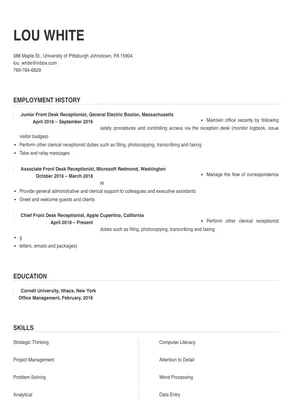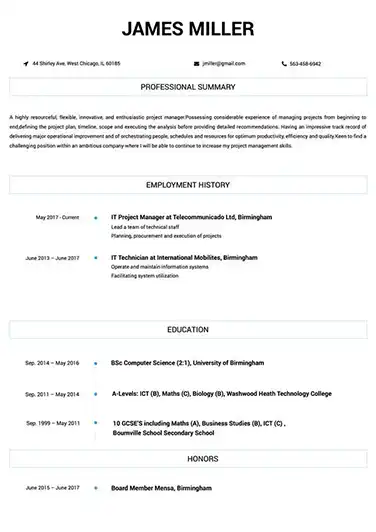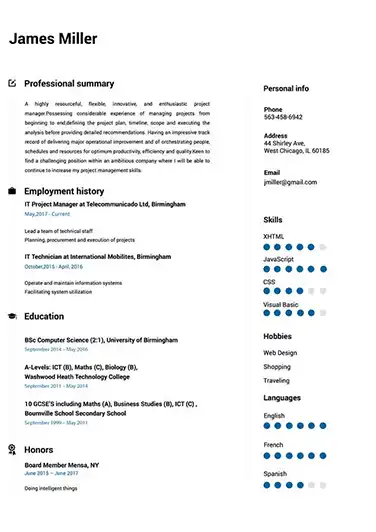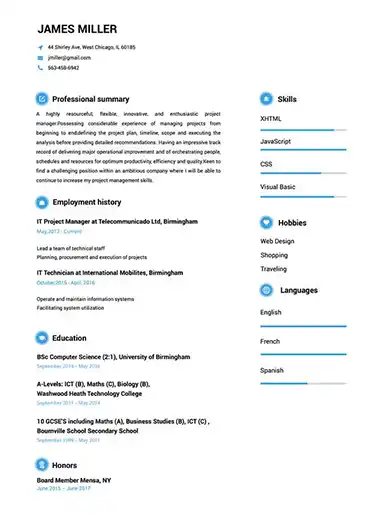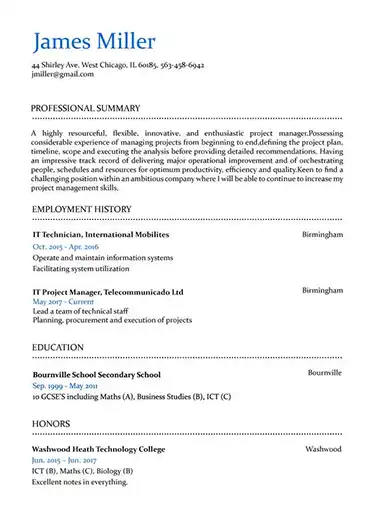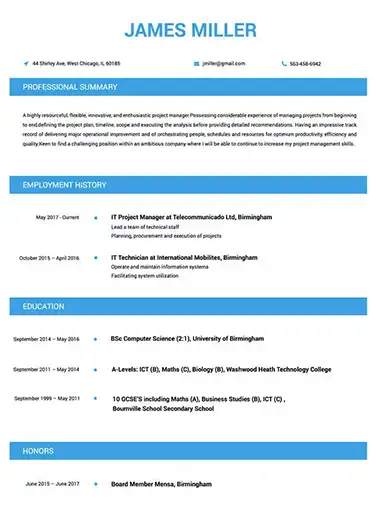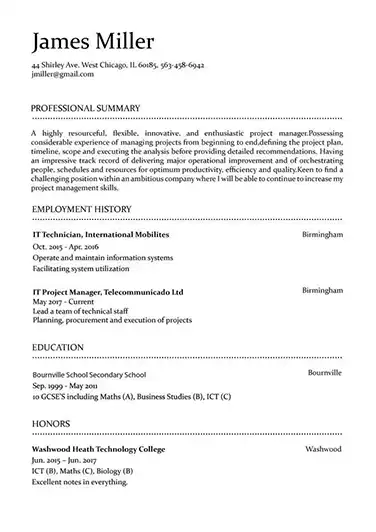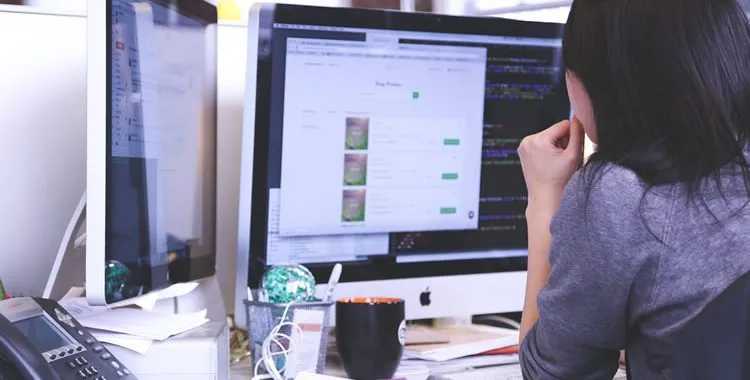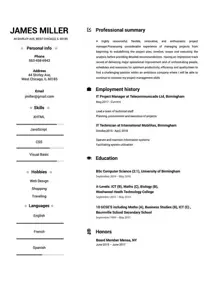 Use This Template
Use This Template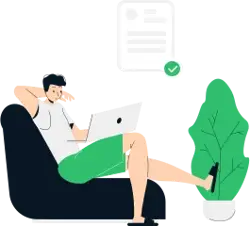
Build your resume in 15 minutes
Create an awesome resume that meets the expectations of potential employers with our selection of professional, field-tested resume templates.
front desk receptionist: Resume Samples & Writing Guide
lou_white@inbox.com
769-784-6829
Employment history
- Perform other clerical receptionist duties such as filing, photocopying, transcribing and faxing
- g
- letters, emails and packages)
- Manage the flow of correspondence (e
- Provide general administrative and clerical support to colleagues and executive assistants
- Greet and welcome guests and clients
- Maintain office security by following safety procedures and controlling access via the reception desk (monitor logbook, issue visitor badges)
- Perform other clerical receptionist duties such as filing, photocopying, transcribing and faxing
- Take and relay messages
Education
Skills
Do you already have a resume? Use our PDF converter and edit your resume.
taylorhal16@yandex.com
689-377-7440
Employment history
- Update calendars and schedule meetings
- Support and facilitate the completion of administrative tasks
- Coordinate office activities
- Support and facilitate the completion of administrative tasks
- g
- Answer, screen and forward incoming phone calls
- Perform other clerical receptionist duties such as filing, photocopying, transcribing and faxing
- letters, emails and packages)
- Greet and welcome guests and clients
Education
Skills
kylelong61@gmail.com
963-639-3571
Employment history
- Support and facilitate the completion of administrative tasks
- Prepare reports and documents when needed
- Greet and welcome guests and clients
- letters, emails and packages)
- g
- Greet and welcome guests and clients
- Manage the flow of correspondence (e
- Handle requests for information and data
- g
Education
Skills
robinsondanny10@outlook.com
940-401-5624
Employment history
- Perform other clerical receptionist duties such as filing, photocopying, transcribing and faxing
- Monitor and maintain office supplies inventory
- Provide general administrative and clerical support to colleagues and executive assistants
- letters, emails and packages)
- Maintain office security by following safety procedures and controlling access via the reception desk (monitor logbook, issue visitor badges)
- Monitor and maintain office supplies inventory
- Take and relay messages
- Provide basic and accurate information in-person and via phone/email
- Receive, sort and distribute daily mail/deliveries
Education
Skills
xaviero.jackson@yahoo.com
739-875-1061
Professional Summary
Employment history
- Prepare reports and documents when needed
- Support and facilitate the completion of administrative tasks
- Perform other clerical receptionist duties such as filing, photocopying, transcribing and faxing
- Greet and welcome guests and clients
- Receive, sort and distribute daily mail/deliveries
- Prepare reports and documents when needed
- Manage the flow of correspondence (e
- letters, emails and packages)
- Answer, screen and forward incoming phone calls
Education
Skills
Not in love with this template? Browse our full library of resume templates
Are you a front desk professional who’s always wondered why everyone else seems to get hired for the jobs you’re gunning for? It can be hard to deal with being passed up time and time again for another candidate. It’s especially difficult when you know you have precisely what it takes to be the best front desk professional for the role.
If you’re tired of thinking “Why not me?” it’s time you tackled this problem head-on. You can make 2020 the year you finally get your dream front desk job by fixing up the very thing that’s stopping your job applications from progressing. If you haven’t already guessed, we’re talking about your resume; the humble but powerful document that will make or break your chances of getting a job.
After all, it isn’t just luck that other candidates continually get called in for interviews and eventually get hired. It’s because their resumes provide recruiters with precisely what they’re after. Keep in mind that even if you’re the right candidate for the job, the only way a recruiter will discover this fact is via your resume.
This is why not just any resume will do on your job search. You need to piece together a resume that recruiters can’t get enough of. The good news is that you don’t need to be a resume writing whiz to create such an impressive resume. You simply need to follow some expert tips to ensure your resume ticks all the right boxes.
To this end, we’ve created a comprehensive guide to highlight exactly how you can create a front desk resume that exceeds recruiters’ expectations. It’s designed to help front desk professionals – including front desk receptionists, specialists, and agents – to fulfill their career goals. If this is you, be sure to take a careful read of it from start to finish. In this front desk resume example and guide for 2020 you’ll discover:
- The best resume format to use
- Which resume sections are pivotal to include
- How to select and highlight the most appropriate skills
- Why a resume objective or summary is so impactful
- How to effectively differentiate your resume from the pack
1. Multiple Template Examples
2. How Do You Write a Job-Winning Front Desk Receptionist Resume?
How should you format your resume?
If you want your front desk resume to be taken seriously by recruiters, you need to correctly format it. Wondering why is this so important to do? Most recruiters won’t give the time of day to any resumes that require expending energy to read them. Consequently, if your resume appears to be disorganized or illogically structured, your resume won’t stand a chance in a pool of well-formatted resumes.
That’s why you need to ensure yours is equally, if not better formatted than the resumes of other candidates. The most reliable resume format to use is reverse-chronological format. It presents your resume in an organized and logical manner, so most recruiters are happy to give it a big tick of approval.
Reverse-chronological format is ideal for experienced front desk professionals to use because it draws strong attention to your career progress. It does this in two ways. Firstly, by ordering each of your professional experiences from most to least recent, and secondly, by positioning your “Employment History” section as the first major section that appears under your “Resume Objective” or “Resume Summary.”
Another consideration to be mindful of if you want to keep on the good side of recruiters is your resume’s layout. If you want to ensure you please them, you’ll need to abide by some standard guidelines regarding your resume’s length, fonts, margins, and line spacing, as well as header and text size. We’ve conveniently detailed the most critical ones to follow below:
- Number of Pages: 1 page at most.
- Fonts to Use: Any that exude a professional air, such as Cambria or Arial.
- Fonts to Avoid: Any that would be inappropriate to use to type an email to a guest, such as Narnia and Fancy Pens
- Margins: 1 inch on all sides.
- Line Spacing: 1 or 1.15.
- Header size: 14-16 point size.
- Text size: 11-12 point size.
Pro tip: Make sure your email address looks professional. Recruiters have been known to dismiss excellent resumes simply because a candidate’s email address is juvenile. So instead of something like kittycat286@gmail.com, opt for a simple email address based around your name such as [first name].[surname]@gmail.com or [first name initial].[surname]@gmail.com
Which sections should be included in a resume?
As you’re making your resume, it’s important to keep in mind that there are a number of fundamental sections that must be included. Below, you’ll find an overview of each of the 6 major sections that every resume should have:
- Contact Information: Recruiters expect that you’ll state key details about yourself so that they can either get in touch with you if needed or look further into your professional experiences. Be sure to include your name, phone number, email address, and home address in this section. While optional, we recommend also including your LinkedIn profile URL.
- Resume Objective or Resume Summary: Entry-level and experienced front desk professionals should include a resume objective or summary respectively directly underneath the contact information section. Within 2 to 4 sentences, you should provide the recruiter with: a) an overview of who you are as a professional and b) clear reasons why you’re worth hiring.
- Employment History: This section should showcase an overview of your work history. For each role, provide the name of the company, your job title, and the dates you worked. Most importantly, you should highlight your most relevant and eye-catching achievements for each one that a recruiter would be interested in.
- Education: Whether your highest level of educational attainment is your high school diploma or you have a college degree to your name, you’ll need to list key details about your diploma and/or degree in this section.
- Training and Certifications: Have you undertaken any training courses or certifications that will help you to perform the job you’re applying for? This is the section you should note them in.
- Skills: List 6 to 8 of your most stand out skills here. Make sure that the ones you include are directly relevant to the job you’re applying for. You may be asked to prove them, so be prepared to do so if asked.
What will recruiters look for in your front desk receptionist resume?
Making your front desk resume without giving proper consideration to what recruiters are looking for is a surefire way to fall short of their expectations. Keep in mind that it’s usually up to recruiters who will end up getting through to the interview round. Consequently, if you fail to impress them, you can pretty much wave goodbye to your chances of getting hired.
So what are recruiters after exactly in your front desk receptionist resume? They want to see that your resume visually looks the part, with clear formatting and a nice layout. Your resume should also feature relevant information about your professional background. Namely, you should include key details such as your employment history, skills, educational background, training and certifications, and so on.
The information you include should leave them with no doubt that your application is worth giving serious consideration to. Recruiters will ultimately be looking to see how well your resume addresses the criteria listed in the job ad of the role you’re applying for.
In order to create a resume that matches up with this criteria, you will need to target and customize your resume to each specific job. You can do this by emphasizing the parts of your professional background that are most relevant to the given job.
How do you get your resume past ATS?
Now that you know how to get on the good side of recruiters, it’s time to learn how to get on the good side of robots. Yes, you read that right! You need to understand how to work your way around the ATS, which stands for ‘Applicant Tracking System.’ ATS is a type of recruitment software that is widely used in the HR world. This software is often nicknamed ‘robots’ because it relies 100% on technology to assess whether your application should pass through to the next round or not.
ATS will usually look at both your resume and cover letter (if you submit one) to determine whether you could be the right candidate for the job. Unlike the nuanced approach humans can evaluate your application, ATS is very clear cut in its approach. In short, there is no gray area when it comes to the ATS.
The ATS will primarily judge your application based on whether or not it contains relevant keywords from the job ad. Keywords are words that indicate the most desirable qualities a recruiter is seeking from an ideal candidate. Keywords can be:
- Hard and soft skills
- Job titles
- Any other attributes an ideal candidate should have
Therefore, if you want to get your resume past ATS, you must incorporate the keywords you identify in a job ad throughout your resume. But don’t make the mistake of arbitrarily adding keywords where they don’t belong, like this candidate did with the keyword ‘answer phone calls’:
- Answer calls every day in the manner that staff were expected to answer calls.
As you can tell, the candidate tried to target the keyword twice when it was unnecessary and in turn unnatural to do so. This is called ‘keyword stuffing.’ Candidates may keyword stuff in a mistaken belief that the more times they include a keyword the more ‘points’ the ATS will give their application.
Not only is this completely false, but it’s a practice that is heavily frowned upon by recruiters. Consequently, if they catch you keyword stuffing (and you can bet they do!), your chances of getting hired will be zilch. Speaking of impeding on your chances of getting hired, a recruiter will also bring your application to a halt if they catch you lying on your application.
That’s why we strongly recommend candidates to: a) only focus on keywords that genuinely apply to their professional skills and experiences and b) incorporate skills in a natural way. The following example shows how another candidate naturally incorporated the same keyword into their resume:
- Answer calls every day in a prompt and professional manner that aligned with the club’s communication guidelines.
What skills to mention and how to do it correctly?
One of the trickiest parts of making your resume is trying to work out which skills are most valuable to mention. Luckily for you, there’s a method you can use to ensure that you feature the very skills a recruiter is after.
This method simply involves carefully reading through the job ad of the job you want and identifying keywords focused on skills. (If you need to catch up to speed on what keywords are, read the section directly above).
After you have created a list of the skills-focused keywords featured in a job ad, you can begin incorporating the ones that match with your skill set into your resume. You will need to add any relevant keywords to 3 main sections:
- “Resume Objective” or “Resume Summary” section: Feature a handful of soft and hard skills that you believe truly set you apart as a candidate.
- “Skills” section: This section of your resume is wholly dedicated to showcasing your hard and soft skills. Select 6 to 8 of your most impressive skills to list here.
- “Employment History” section: This section is your opportunity to shine a spotlight on your work achievements and the skills you needed to draw on to make them happen. Aim to feature at least one skill per achievement where appropriate.
So what kinds of skills can you generally expect recruiters to be on the hunt for? We analyzed dozens of front desk job ads to identify the most sought-after skills for this profession. Check out the lists below to see which ones you have:
Soft skills
- Positive, can-do attitude
- Written communication skills
- Organizational skills
- Excellent customer service skills
- Ability to take initiative
- Adaptability
- Multi-tasking
- Performs well with frequent interruptions
- Time management skills
- Ability to work in a team
Hard skills
- Proving exceptional customer service to guests while anticipating their needs
- Answering phone calls and emails
- Ensuring proper standards of hospitality are provided to all members and guests on property and/or via telephone
- Booking reservations and coordinating registrations
- Providing information to guests about company policies, services, and amenities
- Providing information, directions, and other assistance as necessary
- Following through on member and guest requests and/or concerns in a timely manner
- Completing special projects, stocking items, listing items to be ordered, etc
- Computing billing charges, collecting payments, and providing change
- Posting charges as received through other departments
Pro tip: Computer proficiency (e.g. ability to use Microsoft Word, Excel, Outlook, etc.), as well as knowledge and usage of correct business English are two of the most vital skills recruiters look for in front desk resumes. Even if a job ad doesn’t specifically state that candidates should possess these skills, it’s worthwhile to mention them in your resume.
How to write a resume objective or summary? When should you include each one?
Opening your resume with a resume objective or resume summary is a fantastic way to grip a recruiter as soon as they set their eyes on your resume. Think of these sections to be akin to the overview you would give to guests as a front desk receptionist of a hotel. Before handing over the keys to their room, you would describe which features they can expect to find in their room in an effort to orient them.
A resume objective and resume summary similarly provide a recruiter with a helpful overview of which features about yourself they can expect to find in your resume. Instead of presenting section after section of information about yourself without any initial context of who you are, these sections aim to ease the recruiter into your resume by highlighting the most eye-catching qualities about yourself that they should be aware of.
Just keep in mind that you should only include one or the other! Keep reading to learn more about each of these sections.
Resume objective
Who should write it? Entry-level candidates with little or no experience.
How long should it be? 2 to 4 sentences.
What should it focus on? Any relevant qualities you offer as a candidate, in addition to any other notable information, that will convince a recruiter to kick start your career as a front desk receptionist.
Example of a bad front desk resume objective:
- Aspiring front desk receptionist who is ready for all of the challenges that come with this role! I have droves of enthusiasm and a bunch of other skills that are sure to come in handy. Unfortunately, I don’t have any experience in this role, but I know that I’ll excel in this job like a fish takes to water as soon if I get the chance to prove myself.
What’s the matter with this resume objective? For starters, the candidate doesn’t compliment their high level of enthusiasm with any relevant attributes that a recruiter would be interested in. The candidate claims that they’re “ready for all of the challenges” of the role and that they have a “bunch” of relevant skills, but doesn’t offer clarification of what these skills are.
The candidate also makes the fatal mistake of explicitly stating that they’re completely inexperienced. Even if this is indeed true, it’s unnecessary to state this fact as a recruiter will work this out for themselves. Doing so simply gives the recruiter another reason to question your applicability.
Finally, as we touched on above, the tone of the entire resume objective is off. It is far too casual for a resume, which is a serious document that should be written in a professional manner.
Example of a great front desk resume objective:
- Aspiring front desk receptionist who has proven time management and organizational skills. With 2+ years in customer service and as a 2x winner of my current workplace’s ‘Server of the Month’ award, I understand how to communicate with customers in a clear and friendly manner. I additionally possess strong computer literacy skills. I wish to bring these skills to the role at Claremont Hills Hotel.
To get to the heart of why this resume objective is superior to the previous one, ask yourself if you could immediately tell that the candidate has no prior experience as a front desk receptionist.
We’re guessing you didn’t. The reason the candidate was able to divert attention away from their inexperience isn’t just because they didn’t explicitly mention it, like the previous candidate did.
It’s because they strongly emphasized their most relevant attributes that align with those the recruiter is searching for. The candidate does this by highlighting their soft skills (time management, organizational skills, customer service skills) and hard skills (computer literacy skills). The candidate also shows that they have a number of years of relevant experience in customer service, and even provide a tangible example of their skills.
Resume summary
Who should write it? Experienced candidates who have worked as a front desk receptionist for at least a couple of years.
How long should it be? 2 to 4 sentences.
What should it focus on? The fact that you offer relevant experience, in addition to relevant skills and attributes, that will make you a shoo-in for the job.
Example of a bad front desk resume summary:
- Front desk clerk who is an old hand at the job. You won't need to worry whether I will transition smoothly into the role because I offer an array of useful skills every front desk clerk should possess. I have worked in a similar workplace to your one, so I am confident that I will be an excellent addition to your talented team.
The biggest problem with this resume summary is that it’s written in a very wishy-washy way. Take a look again and you’ll see that it doesn’t paint a very clear picture of who the candidate is as a professional or why they’re the ideal front desk clerk for the job.
For example, they state that they’re “an old hand at the job” and offer experience working in a “similar workplace” to that of the company they’re applying for. A recruiter would be unimpressed by these vague statements because they leave them with more questions than answers.
What’s more, the vagueness of this resume summary would make a recruiter suspect that it is used in each application the candidate submits, rather than for the specific company the recruiter is hiring for.
Example of a great front desk resume summary:
- Front desk clerk with 3+ years of experience working in private medical practices. As a front desk clerk for Dr. McGregor’s clinic, I would draw on my proven oral and written communication skills, appointment scheduling skills, and strong computer literacy skills. As a testament to my exceptional customer service skills, over 50 customers have left positive feedback about their interactions with me on my current company’s Google Maps page.
This resume summary is tenfold more attention-grabbing than the previous one. It all comes down to the fact that the candidate has summarized their most attractive and relevant qualities to essentially frame themselves as an ideal candidate for the job.
For example, unlike the previous candidate, they leave no doubt in the recruiter’s mind that they are an experienced front desk clerk who has appropriate experience to excel in the given job. The candidate provides a rich insight into their relevant soft skills (oral and written communication skills, organizational skills, and customer service skills) in addition to their relevant hard skills (computer literacy skills and appointment scheduling skills).
To really set themselves apart, the candidate quantifies one of their particularly impressive achievements by sharing that many customers have left positive reviews about them.
If you want to write a resume summary that sounds equally as enticing, make sure to apply these tips when writing yours.
Pro tip: To reassure recruiters that you wrote your resume objective or summary for the particular job you’re applying for, always make sure to mention the name of the company you’re applying to work at.
How to write a front desk receptionist resume when you have little or no experience?
Whether you’re seeking a career change or want to begin your working life as a front desk receptionist, you may be struggling to make an attractive resume. It can definitely be a headache to figure out how to fill yours out if you have little to no experience. Here are our top tips to keep in mind to get you on the right track:
- Apply for the right type of jobs: We hate to break it to you, but you won’t have much luck convincing a recruiter to give you a chance on a role for a candidate with years of experience. In most cases, no amount of enthusiasm can make up for a job that requires experience. What should you do, then? Apply for jobs that compliment your entry-level credentials. Once you start applying for these types of jobs, you’ll find it tenfold easier to meet the job criteria and show a recruiter you’re the ideal candidate for the job.
You can track down these jobs by changing the search terms you use. For example, search for “Junior” or “Entry-Level” front desk receptionist jobs. When you’re scanning through job ads, look for words like, “No prior experience or training required” as well as “This position does not require licenses or certifications.”
- Apply for jobs through a staffing agency: One easy way to rack up some relevant work experience and skills is to sign up to a staffing agency (also referred to as a staffing company or employment agency). If you have absolutely zero experience in the field, it may be worthwhile to take on a few temporary front desk jobs so that you can start to fill up your resume. Keep in mind that temporary jobs can in fact turn into full-time jobs, so make sure to take the job seriously, even if it’s only for a day!
- Focus on your soft skills: If you’re still finding it difficult to tick the boxes in terms of the hard skills needed for certain front desk jobs, you should focus more on your soft skills instead. Many front desk jobs will offer on-the-job training for the practical skills you will need anyway, so you can quickly catch up to speed once you get your foot in the door.
However, what can’t be as readily taught are relevant soft skills. Front desk jobs heavily rely on strong soft skills, so making it clear you have these is pivotal. Remember, you don’t need to have utilized the soft skills in a front desk work setting in order to include them; you can include any that you have utilized in your previous roles or even during your studies.
How do you make your resume stand out?
Want to make a resume that stands out from the hundreds of other ones a recruiter will receive? It’s a daunting task, but it’s entirely achievable. Follow our expert tips below to create a lasting impression on a recruiter.
- Aim for simple but powerful aesthetics: Have you been browsing the web for an eye-catching resume template? One with lots of colors, graphics, and fun fonts? These may seem like the key to making your resume stand out, but it will likely do the opposite. In fact, many of the resume templates companies try to sell can’t even be read by the ATS!
The best way to stand out when it comes to your resume’s aesthetics is to keep things looking clean and simple. You don’t need to reinvent the wheel to get a recruiter’s attention. Recruiters appreciate easy-to-read resumes, so you won’t be helping matters with a busy template. That’s why we strongly suggest opting for an HR-approved and ATS friendly resume template. - Don’t sell yourself short: Modesty can be an important trait to demonstrate at times in the workplace. However, you should leave your modesty at the door when writing your resume. Remember that your resume is the first (and usually, only) shot you have to make an impression on a recruiter.
So if you achieved something big or have a very attractive skill set, be sure to make them shine. Of course, it’s equally important not to come across as too full of yourself either, so be sure to keep your tone in check and provide solid examples of your attributes throughout your resume.
- Customize your resume: You may recall that we mentioned how important it is to target and customize your resume to each specific job. But just in case you didn’t get the memo, we want to reiterate this point because it is critical to ensuring that your resume stands out. After all, if there’s one thing that all recruiters can agree on, it’s that a customized resume beats a generic resume any day of the week.
So you should seriously think twice before submitting the same resume you’ve used for every other job application. Recruiters will be able to detect that your resume isn’t tailor-made for the job in an instant. Instead of giving them an excuse to choose another candidate over you, ensure that you modify your resume each time so that it ticks all of the boxes a recruiter is after in an ideal candidate.
3. How to Make a Resume Using Resumebuild.com’s Resume Builder Tool That Will Get You Hired
If you’ve read completely through our resume guide, you’re off to a good start. Now that you’ve discovered what you need to do to make a wonderful front desk receptionist resume, it’s time to put all of our insider tips into action. To do so, you’ll need to set aside some quality time to bunker down and start working on your resume.
So...what exactly is stopping you from doing this? For starters, trying to find time in between work and everything else you have going on in your life can be incredibly difficult. Then, there’s the consideration of your motivation to do so – or lack thereof! After all, who wants to spend their weekends and nights off at their computer desk trying to come up with captivating sentences and deciding on which font is best for their resume? Your hesitation may stem from your lack of confidence in your abilities to make an amazing resume.
The solution to all of these roadblocks is our state-of-the-art resume builder at Resumebuild.com. We’ve designed it to address each of these problems directly, so that you can create your resume quickly and easily. To be clear, when you use our resume builder, you won’t just end up with some scrappy resume that fails to connect with recruiters.
Our resume builder helps job seekers create resumes that are of a professional quality in both looks and substance. It does this by guiding you to complete each major section of your resume from A to Z. For example, if you’re not much of a writer, you’ll be able to use the dozens of pre-written examples we’ve included right within the builder. If it’s formatting you’re worried about, you can choose from our wide variety of HR-friendly resume templates.
Ready to begin? Get on track to your dream job by making a job-winning resume at Resumebuild.com.
front desk receptionist Job Descriptions; Explained
If you're applying for an front desk receptionist position, it's important to tailor your resume to the specific job requirements in order to differentiate yourself from other candidates. Including accurate and relevant information that directly aligns with the job description can greatly increase your chances of securing an interview with potential employers.
When crafting your resume, be sure to use action verbs and a clear, concise format to highlight your relevant skills and experience. Remember, the job description is your first opportunity to make an impression on recruiters, so pay close attention to the details and make sure you're presenting yourself in the best possible light.
front desk receptionist
- Protect the security of medical records to ensure that confidentiality is maintained
- Retrieve patient medical records for physicians, technicians, or other medical personnel
- Review records for completeness, accuracy, and compliance with regulations
- Release information to persons or agencies according to regulations
- Answering multi-phone line and transferring to correct department
- Open waiting room and keep tidy
- Collect copay and verify insurances
front desk receptionist
- Operate telephone, providing information, taking messages, and scheduling appointments.
- Greet patients, check them in, and print medical records.
- Keep track of notes, insurance, and medical records.
- Check guests into and out of their rooms.
front desk receptionist
- Sorting documents such as Absent, Leave forms of employee
- Monitoring attendance of employees everyday.
- Answering calls from suppliers, stores employee and customers.
- Assisting visitors to meeting room.
- Receiving monthly deliver if stocks.
- Sending outbound documents from office to stores.
- Receiving important documents from banks,supplier,store employee etc.
front desk receptionist
- Provide information about facilities, pricing, and rules and regulations.
- Assist new members on the way the gym operated.
- Clean equipment and report any issues with the equipment to management.
- Answer phone calls and assist prospective members on the gym.
front desk receptionist
- Verify insurance eligibility, complete prior authorizations for GI inpatient procedures.
- Operate telephone switchboard to answer, screen, or forward calls, providing information, page on call physicians, schedule appointments.
- Scan patients’ medical history, vital statistics, or information such as test results in medical records.
- Received a raise within the first few months, due to superb customer service
front desk receptionist Job Skills
For an front desk receptionist position, your job skills are a key factor in demonstrating your value to the company and showing recruiters that you're the ight fit for the role. It's important to be specific when highlighting your skills and ensure that they are directly aligned with the job requirements, as this can greatly improve your chances of being hired. By showcasing your relevant skills and experience, you can make a compelling case for why you're the best candidate for the job.
How to include technical skills in your resume:
Technical skills are a set of specialized abilities and knowledge required to perform a particular job
effectively. Some examples of technical skills are data analysis, project management, software proficiency,
and programming languages, to name a few.
Add the technical skills that will get hired in your career
field with our simple-to-use resume builder. Select your desired resume template, once you reach the skills
section of the builder, manually write in the skill or simply click on "Add more skills". This will
automatically generate the best skills for your career field, choose your skill level, and hit "Save &
Next."
- Computer Literacy
- Microsoft Office
- Data Entry
- Typing
- Filing
- Scheduling
- Reception
- Telephone Skills
- Customer Service
- Time Management
- Organization
- Multi-tasking
- Problem Solving
- Attention to Detail
- Professionalism
- Office Administration
- Word Processing
- Records Management
- Document Management
- Document Preparation.
How to include soft skills in your resume:
Soft skills are non-technical skills that relate to how you work and that can be used in any job. Including
soft skills such as time management, creative thinking, teamwork, and conflict resolution demonstrate your
problem-solving abilities and show that you navigate challenges and changes in the workplace
efficiently.
Add competitive soft skills to make your resume stand-out to recruiters! Simply select
your preferred resume template in the skills section, enter the skills manually or use the "Add more skills"
option. Our resume builder will generate the most relevant soft skills for your career path. Choose your
proficiency level for each skill, and then click "Save & Next" to proceed to the next section.
- Communication
- Interpersonal
- Leadership
- Time Management
- Problem Solving
- Decision Making
- Critical Thinking
- Creativity
- Adaptability
- Teamwork
- Organization
- Planning
- Public Speaking
- Negotiation
- Conflict Resolution
- Research
- Analytical
- Attention to Detail
- Self-Motivation
- Stress Management
- Collaboration
- Coaching
- Mentoring
- Listening
- Networking
- Strategic Thinking
- Negotiation
- Emotional Intelligence
- Adaptability
- Flexibility
- Reliability
- Professionalism
- Computer Literacy
- Technical
- Data Analysis
- Project Management
- Customer Service
- Presentation
- Written Communication
- Social Media
- Troubleshooting
- Quality Assurance
- Collaboration
- Supervisory
- Risk Management
- Database Management
- Training
- Innovation
- Documentation
- Accounting
- Financial Management
- Visualization
- Reporting
- Business Acumen
- Process Improvement
- Documentation
- Relationship Management.
How to Improve Your front desk receptionist Resume
Navigating resume pitfalls can mean the difference between landing an interview or not. Missing job descriptions or unexplained work history gaps can cause recruiters to hesitate. Let's not even talk about the impact of bad grammar, and forgetting your contact info could leave your potential employer hanging. Aim to be comprehensive, concise, and accurate.
jake_austin@outlook.com
984-885-2306
Employment history
- Update calendars and schedule meetings
- Provide general administrative and clerical support to colleagues and executive assistants
- Receive, sort and distribute daily mail/deliveries
- Provide basic and accurate information in-person and via phone/email
- Receive, sort and distribute daily mail/deliveries
- Provide general administrative and clerical support to colleagues and executive assistants
Education
Skills
Unexplained Year Gaps and Missing Job Experiences are a No-no
Gaps in your resume can prevent recruiters from hiring you if you don't explain them.
Key Insights- It's okay to have gaps in your work experience but always offer a valid explanation instead of just hiding it.
- Use the gap to talk about positive attributes or additional skills you've learned.
- Be honest and straightforward about the gap and explain it using a professional summary.
How to Optimize Your front desk receptionist Resume
Keep an eye out for these resume traps. Neglecting to detail your job roles or explain gaps in your career can lead to unnecessary doubts. Grammar blunders can reflect negatively on you, and without contact information, how can employers reach you? Be meticulous and complete.
Professional Summary
Employment history
- Letters, emails, and packages)
- Take, and relay messages
- Provide general, administrative, and clerical support to colleagues, and executive assistants.
- Greetd and welcom guests and clientss
- Co-ordinate office activitiess
- Receieve, sort and distrubute daily mail/deliveriess
- Letter, emails, and packages)
- Maintain office security by following safety proceduers and controling access via the reception desk (monitor logbook, issue visitor badgs)
- Support and faciliate the completetion of administrativ tasks".
Education
Skills
Avoid Spelling Mistakes and Include your Contact Information
Missing contact information prevents recruiters from understanding you're the best fit for the position.
Key Insights- Make sure you're not missing contact information on your resume. That should include your full name, telephone number and email address.
- Make sure to use a professional email address as part of your contact information.
- Highlight your contact information and double check that everything is accurate to help recruiters get in touch with you.
front desk receptionist Cover Letter Example
A cover letter can be a valuable addition to your job application when applying for an front desk receptionist position. Cover letters provide a concise summary of your qualifications, skills, and experience, also it also gives you an opportunity to explain why you're the best fit for the job. Crafting a cover letter that showcases your relevant experience and enthusiasm for the Accounts Payable role can significantly improve your chances of securing an interview.
White lou_white@inbox.com
769-784-6829
386 Maple St., University of Pittsburgh Johnstown, PA
15904
General Electric
Boston, Massachusetts
To the respected General Electric Recruitment Team
I am excited to apply for the Chief Front Desk Receptionist position at General Electric. As a highly skilled Front Desk Receptionist with 7 years of experience in Administrative & Clerical, I am confident that I can contribute significantly to your organization.
As someone who has always been committed to making a positive impact on the world, I have pursued opportunities to contribute to my community through my work wherever I may be. My experience in this field has equipped me with the skills and knowledge necessary to succeed throughout my life and I am confident that they will help me to bring my passion and expertise to your organization and help drive your success.
I appreciate the opportunity to apply for the Chief Front Desk Receptionist position. I am confident that I can make a valuable contribution to your organization and that together there is no challenge that we cannot overcome. I will be waiting, hopeful for what the future will bring.
Cordially,
Lou White
769-784-6829
lou_white@inbox.com
Lou White
Showcase your most significant accomplishments and qualifications with this cover
letter.
Personalize this cover letter in just few minutes with our user-friendly tool!
Related Resumes & Cover Letters

Build your Resume in 15 minutes
Create an awesome resume that meets the expectations of potential employers with our selection of professional, field-tested resume templates.
